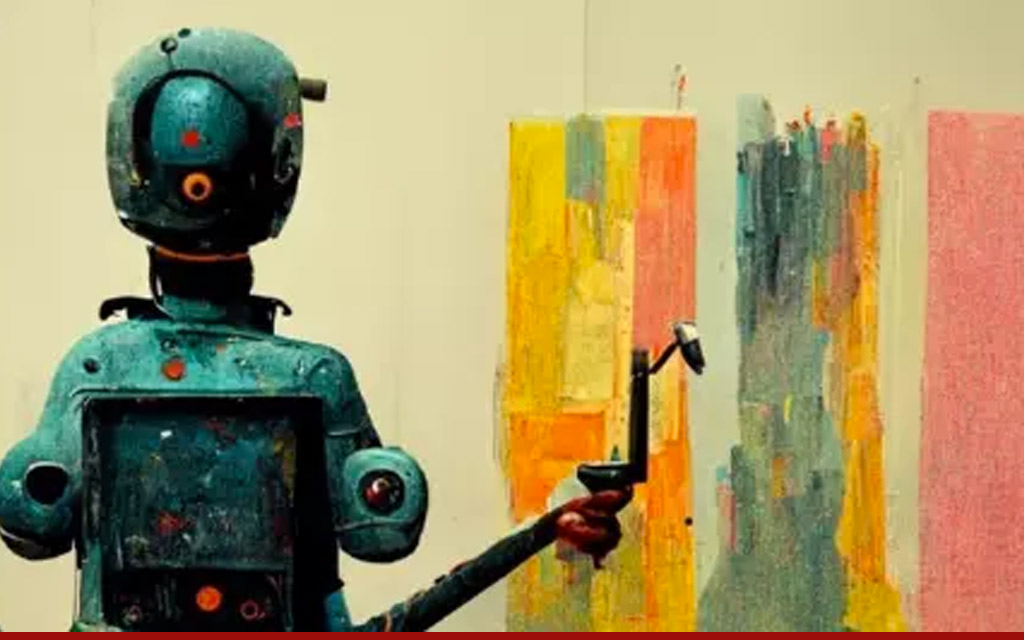AI-generated art from emerging products like Dall-e and Midjourney begs the question of what is creativity, what is art, who makes it, and who owns it.
At this year’s Colorado State Fair, it wasn’t Grandma Nancy or Aunt Bea that walked away with the most talked about prize. It was a video game artist named Jason Allen.
The category Allen entered was “digitally manipulated photography,” but Allen didn’t exactly labor pixel-by-pixel, or just do a little post-production on a photo. Actually, he didn’t do much art at all. The main thing he did was give some text descriptors to midjourney, an AI-generating art program. He described the scene in some detail. The AI turned his prompts into images for the final version. (He did do a bit of retouching using other digital tools.)

Allen reportedly made it clear when he entered the contest that his submission was AI-generated. But apparently the judges didn’t pay much heed. What has ensued since his win is a heated debate about what constitutes art. And by the way—what does it mean to be an artist?
Two of the most popular AI-generated art creation tools are Dall-e 2, from San Francisco nonprofit OpenAI, and Midjourney, created by a small private research lab, are. They both are moving out of stealth and beta modes and becoming used more widely. In the process, they are sending into a tizzy the worlds of fine art, graphic illustration, advertising, and more or less anything that ever required a human artist’s touch.
While they each use variations on related technology, the basic idea is to train computers by showing them art and images — millions of millions of them — everything from classical art to Instagram shots. And the images are described using words. Finally, the AI tools are trained to understand the relationship between objects and ideas. That’s why you can ask Dall-e to create things like “two hamsters exploring a calculator”. The software is even trained on artistic styles — pointillism, cubism, realism, or the style of particular artists, like Claude Monet.

Living Artists Take Umbrage
Enter Greg Rutowski, a video game artist. His style is called out by Dall-e and Midjourney prompts using his name. He is not a happy camper. His art is being copied and imitated over and over. According to MIT Technology Review, Rutowski’s name has been used as a prompt more than Michaelangelo’s. Rutowski wants programs like Dall-e and Midjourney to remove “live artists” like himself from their toolkits. So does artist Karla Ortiz, who caught the art world’s attention after she tweeted about her art being used as a prompt.
And it’s not just artists that might face the question of commercial extinction, if tools like this become more widely used. Meta has released background on Make-A-Video and Evoke Music uses text prompts to create and suggest musical compositions. One can imagine a scenario when “human-created” art, video, and music could become relegated to Etsy-like outposts on the web for connoisseurs, while most commercial art becomes machine-generated.
The Humanity Tax

AI-generated art from emerging products like these begs the question of what is creativity, what is art, who makes it, and who owns it. Says Louis Rosenberg, a pioneer in AI and Chief Scientist at Unamimous.AI, a group-think/swarm technology powered by AI: “These generative AI systems will be able to produce in minutes what would take human writers and artists, and composers hours or days or weeks to produce.” The technology itself is remarkable, he says, but it is not creative.
In an interview Rosenberg tells of asking the generative AI program midjourney to create an image of a “robot holding a paintbrush painting a picture.”. (Seen at top.)
The image that’s ultimately created by the computer does convey emotion, is artistic, and certainly has a style, but not only is AI not creative it’s not even intelligent. “The AI has no idea what a robot is or a paintbrush. It has no artistic sensibilities. It doesn’t even know what these words mean.” says Rosenberg.
“And I’m not an artist,” he continues. “I just fed some text prompts into the computer.” The artwork, he contends, is created using a statistical process that correlates imagery with the words and phrases in the prompt.

So where did this “creativity” come from? It comes from the fact that these machines have been trained on millions and millions of images and millions and millions of text prompts. “What it’s really doing,” argues Rosenberg “is capturing collective humanity’s artistic sensibilities and regurgitating them.”
Rosenberg goes so far as to suggest that we might want to consider a “humanity tax” doled out to the people whose collective sensibilities contributed to the algorithmic output. Think of it as sort of a Universal Basic Income to compensate us all, as machines whittle away at even more of our jobs. (Maybe Andrew Yang was on to something after all.)
My own very first attempt at Midjourney (below) produced astounding results that have only gotten better as I’ve become more precise with my prompts (though I’m thinking Midjourney has not had many calls for cornucopias.)
Once again, technology finds itself ahead of the system of rules and regulations (IP, trademarks, copyrights) meant to protect creators. Both Dall-e and Midjourney will charge a monthly fee for using its services after an initial feemium trial. Both plan to allow you to commercialize your results.
This week, not coincidentally, Disney’s latest job posting hinted at the future. It wasn’t a job offer for animators or illustrators. It was for tech-savvy lawyers who are about to deal with some thorny issues.

Source: https://techonomy.com/a-portrait-of-the-artist-as-a-young-algorithm/




